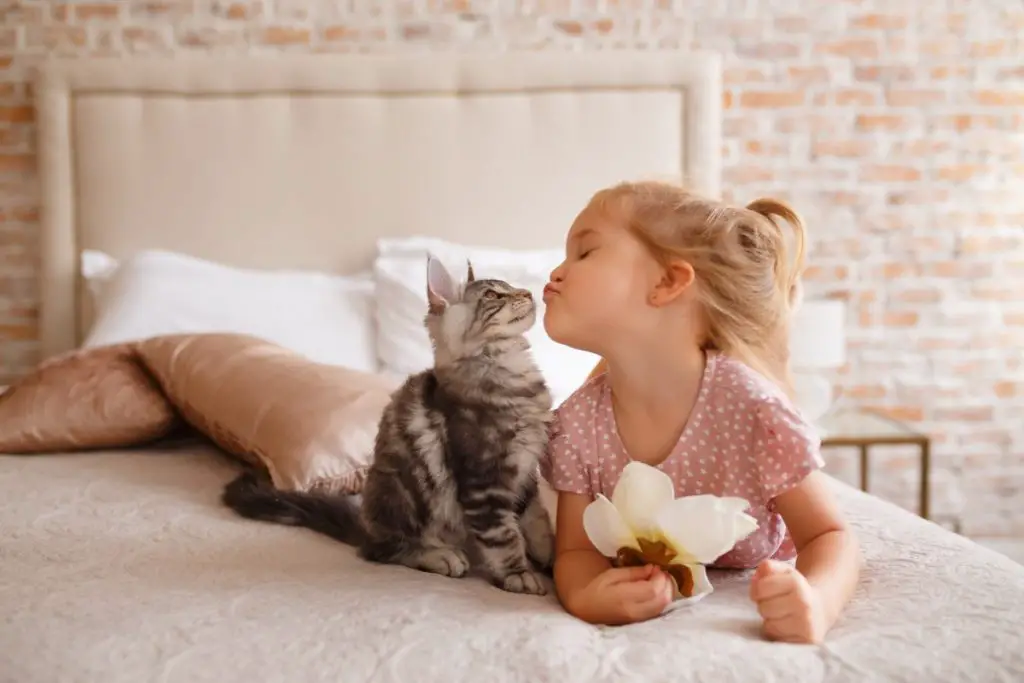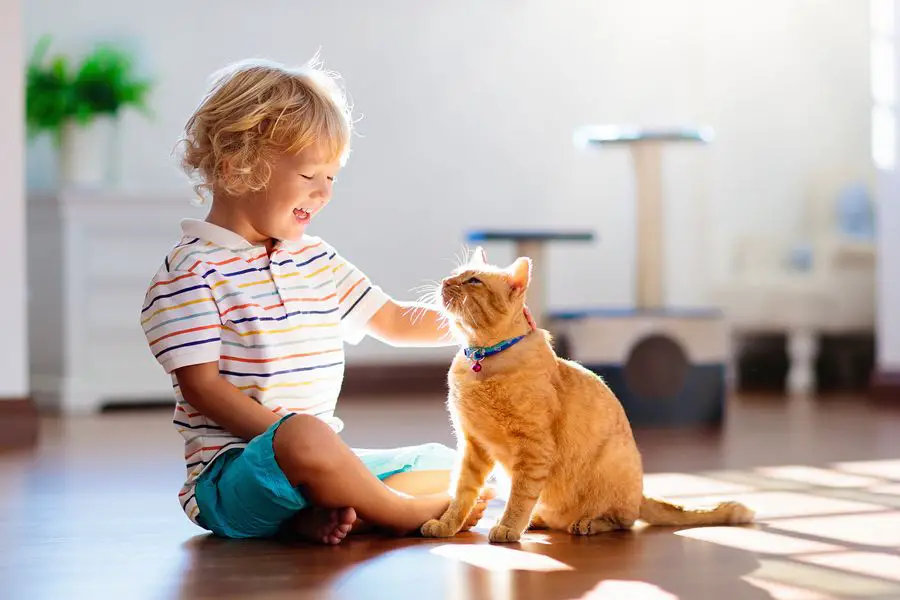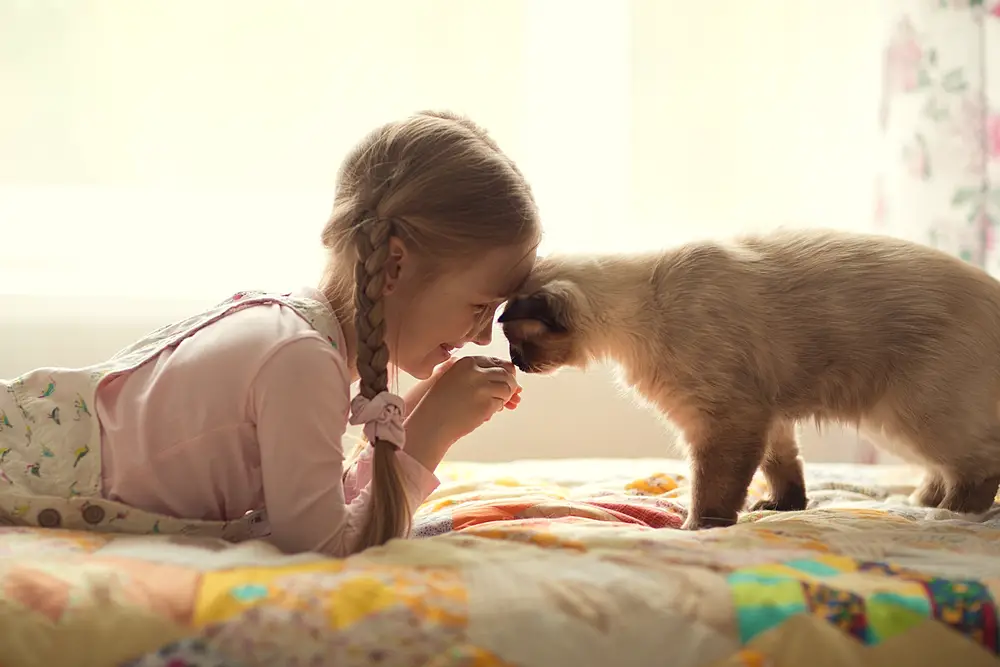Cats have special needs, including the need to interact with humans on their own terms. Teaching your child to be a gentle guardian of a cat means helping him understand and respect the unique characteristics of this animal species.
While your child does not have good results in relation to the cat, you need to monitor all interactions between them. Good communication between a cat and a child does not mean that the child will instinctively develop a connection with the cat.
The relationship between cats and children can be a different story.
Cat behavior is difficult for adults to understand, so we shouldn’t be surprised that children often need guidance on how to live in harmony with a family cat.
Children who learn how to do this will enjoy a good relationship with one of nature’s most beautiful and intriguing creatures.

How To Help A Child Be Gentle With Cats?
Monitor any interaction between children and cats. While your child is not an expert on how and when to touch a cat, you should be present as long as the two are together.
Children act impulsively or on the basis of some frustration when they don’t get what they want, and these are the moments when a cat can be subjected to rough treatment.
By directly observing the way your child interacts with the cat, you can give him advice on how to gently approach the animal, treat it with respect, and redirect its behavior as needed.
Learn The Language Of The Cat’s Body
Your child needs to learn to read cat body language to determine when a cat is happy and content and when it is best to leave it alone.
For example, a relaxed cat who enjoys attention will have a positive attitude by rubbing the child’s body, his clothes, or leaning on him.
Other signs of pleasure are a raised tail. But if a cat moves its tail back and forth, or if its tail is fluffy, touches the floor, or is hidden, it is a sign that it is feeling upset. It can also lower and move its ears back and forth, growl or show its claws.
Touch The Cat The Right Way
There is a right and a wrong way to touch a cat.
The correct shape is with an open hand and a gentle and gentle movement. The wrong way involves pushing, pulling or grabbing in any way.
If your child is very small, you should put his hand in yours while petting the cat.
Teaching young children to run their fingers over the cat’s body, focusing on a very light touch, is often the least stressful way for a cat. Also teach your child to touch only the back, shoulders, neck and upper part of the cat, as the legs, tail and abdomen are forbidden areas.

Teach Your Child To Hold A Cat Properly
Children have sudden and unpredictable movements, and cats do not like surprises. That is why it is very important to teach a child how to hold a cat.
Catching or forcibly holding a surprised cat is a good way for an animal to scratch or bite it. A cat will also run every time it sees a child approaching it. Help your child understand that cats need to do things their way, time, and that forcing a cat is counterproductive.
Have your child sit up and invite the cat to climb into your lap, which may require bait like a treat or toy. If the cat comes and sits in your child’s lap, make sure to touch it with an open hand and gentle movements.
As soon as you notice that the cat is ready to leave, the child should leave it (this is valid at all times, not just this time).
A Lesson On How To Raise A Cat
When your child is ready for the next step, teach him how to raise a cat.
To do this, follow these instructions:
- The child should place one hand under the chest and the other holding the hind legs to lift the cat’s weight evenly.
- Then your child will need to gently hold the cat, place it on its upper body to maintain balance and make the cat safer.
- As soon as the cat wants to get out, try to leave, look at the floor, move its tail or ears, your child should immediately lower it to the ground or to another stable surface – gently and slowly.

Play By Cat Rules
The normal way a child plays is much louder and more active than what a cat can tolerate.
If your child wants to play with a cat, he must learn not to shout, jump or run, because the cat will only be frightened by these activities. Interaction with the cat must be at a time when your child is “quiet”, when he learns to sit still, use his inner voice and be patient with the animal.
Spend peaceful time with your child and cat to build trust in their relationship.
Teach your child how to use a toy when playing with a cat and she will not have the need to scratch or be afraid of a human hand.
Don’t Bother With A Hiding Cat
Cats hide for many reasons, either under the bed, behind the refrigerator or in a tall closet. Harassing a cat that hides and crawls under the bed or removing its hiding place can cause a bite or scratch.
Your child should understand that the cat should go out alone and whenever he wants, or try to lure him with food, an interactive toy and the like. To help your child understand that cats are independent beings who enjoy spending time alone, ask him to help fix some places so the cat can hide there.
Teach your child to let the cat alone when he is in one of his private areas. Cats are not dogs. They are not human either. It is very important that the child understands the nature of cats as a species very different from everyone else.
It is also important for your child to understand that pets are not toys that can simply be left or discarded. When children learn how to treat animals, develop understanding, compassion and a desire to care for them, pets will be their best friends and guardians of childhood.
Did you like our article? Do you have any questions, or thoughts?
Let us know in the comments below! 🙂



Leave a Comment